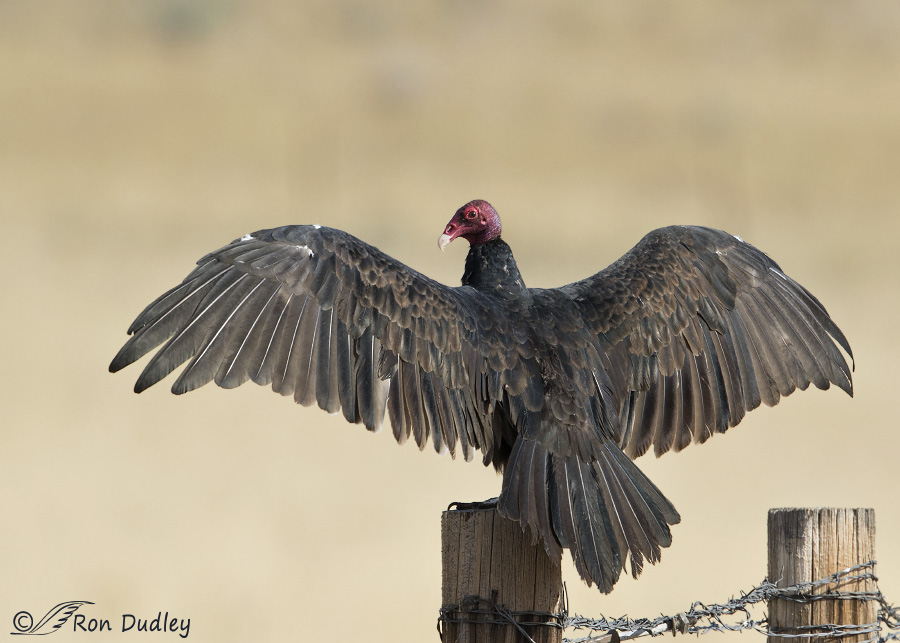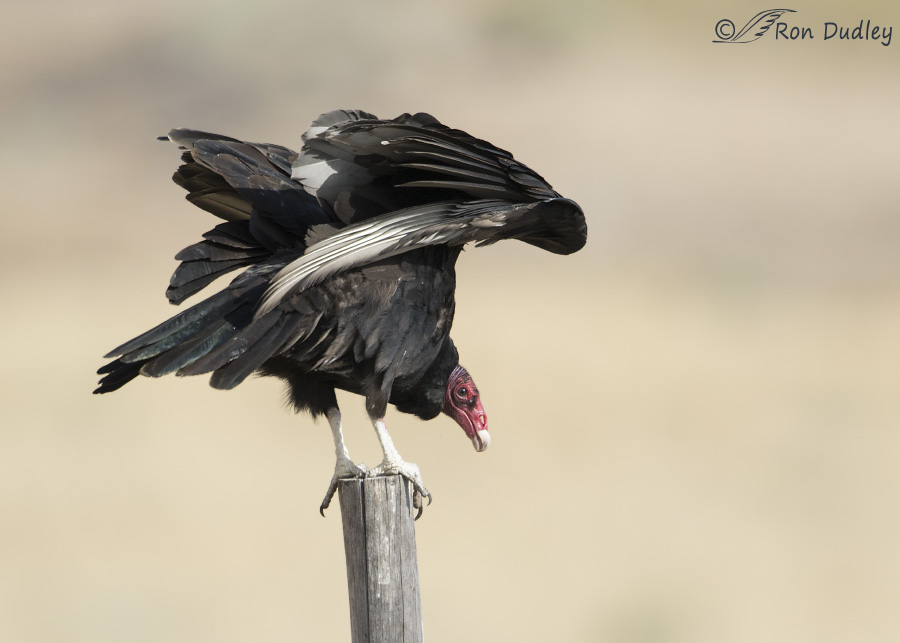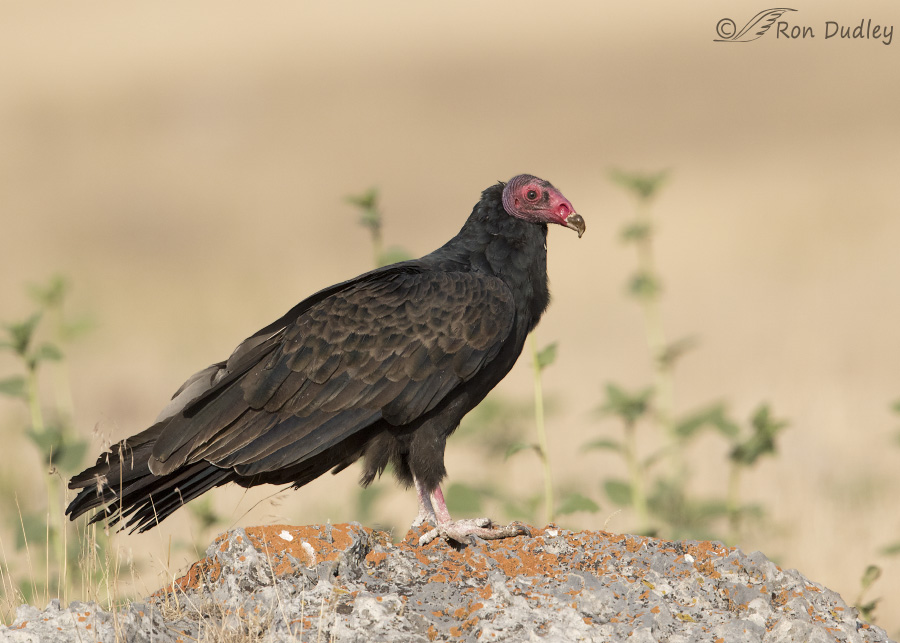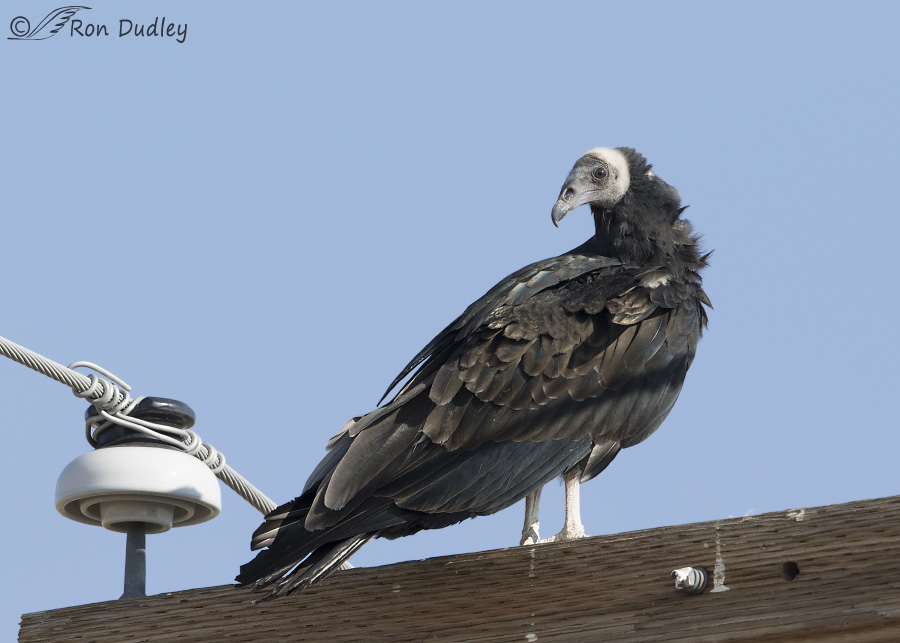The Genus name Cathartes means “purifier” and on this morning the Turkey Vultures were working hard at deserving the moniker.

1/1250, f/8, ISO 640, Canon 7D Mark II, Canon EF 500mm f/4L IS II USM + 1.4 tc, tip of metal post removed, not baited, set up or called in
I don’t think I’ve ever seen so many Turkey Vultures on one morning as I saw six days ago near the Promontory Mountains. At one point a flock of 50-60 of them lifted up off their perches when a juvenile Golden Eagle flew in amongst them and there were smaller groups of them along much of the length of Promontory Road.
This bird was one of a group of about 20 birds that had obviously been feeding on a dead cow in a shallow ravine next to the road. I stopped to photograph some of the resting, preening vultures but my stay there was an unpleasant one because the cow was extremely ripe and aromatic. Turkey Vultures are known for spreading their wings to the sun like this and they do it for a variety of reasons, including using ultraviolet radiation from the sun’s rays to kill potentially harmful bacteria on their plumage from their last meal.

1/1600, f/6.3, ISO 640, Canon 7D Mark II, Canon EF 500mm f/4L IS II USM + 1.4 tc, not baited, set up or called in
Before it eventually took off this vulture performed a wing stretch but kept its eye on me as it did so. The actual color of their legs is pink but they’re usually stained white by their own uric acid. Like some storks, Turkey Vultures deliberately defecate on their legs and feet as a cooling mechanism.

1/4000, f/6.3, ISO 800, Canon 7D Mark II, Canon EF 500mm f/4L IS II USM + 1.4 tc, not baited, set up or called in
Adult Turkey Vultures have white bills but this one is discolored by a gob of some kind of debris, very possibly semi-liquid cow (sorry, I’m sure that’s something you didn’t want to think about…).

1/1000, f/8, ISO 400, Canon 7D Mark II, Canon EF 500mm f/4L IS II USM + 1.4 tc, not baited, set up or called in
In case you’ve never seen one, here’s a juvenile. By next spring its head will turn red and it will attain its full adult appearance some months after that.
Some folks don’t appreciate the appearance or life style of Turkey Vultures but because of their purifying role in the environment that stinky old cow won’t be around long and as one who travels Promontory Road regularly I enthusiastically applaud their efforts.
It took me quite some time to get that nasty smell out of my nostrils and my pickup after I left the scene.
Ron


I used to live in Ohio so the Vultures of Hinkley OH were pretty famous. I really do love vultures.
I really do love vultures.
I’m with you Arwen…I grew up in Cuyahoga Falls (near Akron), so the Hinkley vultures remain in my mind. Back before I knew vultures, I used to laugh at that idea (swallows to Capistrano, vultures to Hinkley), but now that I’ve grown to know and love vultures, I’d make the trip to go see them, just because!
I have never seen a young vulture either. Few years ago vultures would spend the evenings and nights in large trees across the street from my parents home. We would sit on the porch and watch them come and go in the evenings. Made a lot of wing flapping and moving around on the branches. Lots of feathers and poop on the ground. They would head to the mountains in the mornings. Not sure where they went in the winter, but did not hang around in Dayton,Wy. Heard a story that they like to hang around humans most of the time. I bought a fake one and wanted to put it on the porch but Mother would not let me. It was fun to watch catch the air currents and just soar around the area. Never heard any noise from them, other than the wing flapping.
Trudy, northern populations (including Wy) migrate south for the winter. And though they are capable of hissing, other than that they’re largely noiseless because they lack a syrinx (bird’s “voice box”).
Hi Trudy! I lived three years in Ranchester, WY. Should have stayed. I loved it there.
Thanks Ron. I have never seen a juvenile. Handsome lad. Carry Vick’s with you. That should help you encounter a dead cow again.
Jean, I’m not sure I’d appreciate the smell of Vick’s much better…
Ah, yes…the Turkey Vulture…
Here in Leesburg, VA, the unofficial Capitol of Vulturedom on the East Coast, the city fathers have resorted to barrages of fireworks to drive the critters out of town. We have lots of roadkill Whitetail Deer here in Loudoun County, and big swarms of vultures are here more or less year long. Apparently there is a smaller version further west called the “carrion crow,” but I have never really researched that.
Sounds like you’re overrun with vultures, George…
Vultures are really cool folks once you get to know them.
If you’re interested, The Peregrine Fund just posted a really cool feature on vultures since this coming weekend is National Vulture Appreciation Day! Seriously, they’re really cool folks, and as long as you make sure to look alive, they’re pretty interesting.
I’m going down to PA this weekend to a friend’s place. She’s got nesting black vultures in her old barn and the juvie is out and flying about. The whole family is so used to her that they often perch on her roof and watch what she’s doing.
I thought/felt they were smarter than owls and maybe hawks when I did rehab in KY.
We are quick to despise those who do jobs we wouldn’t/couldn’t aren’t we?
Yay for the clean-up crew.
Excellent point, EC!
Ron as always great photos. Apparently we have a lot of them in the desert area around Phoenix Az. I used to think they were eagles but was corrected. I have seen what I think was a turkey vulture swooping down between the rows of houses riding the air currents.
David, I suspect at least some of your vultures in the Phoenix area are Black Vultures – they’re slightly smaller and don’t have red heads as adults.
They are interesting, important birds, but YUK! I’d be gone too with ripe cow in the vicinity! Good pictures and commentary, Ron.
Good pictures and commentary, Ron. 
It takes more than ripe cow to make me leave a photo-op, Judy, but I’ll admit it was close…
Here we go again–OH WOW!
I LOVE vultures. Once you get to know them, they’re pretty cool critters in a lot of ways. Not only do they clean up the mess in The Great Out There, but things like rabies, anthrax and other nasty toxins stop with them. They’re also personable, very curious and pretty darn intelligent. But one warning/wildlife tip–it’s NEVER a good idea to frighten/surprise or threaten them. Their best defensive move is a nicely aimed projectile vomit toward the danger. That stuff wasn’t pretty going down and coming back up again, well, let’s just say it’s some pretty nasty stuff! Trust me on this and don’t ask how I know. Think new pair of shoes!
The uric acid from defecating down their legs also serves to kill the bacteria from the nasty stuff they get into. All things considered, they’re really well designed for the job they do! I just LOVE vultures.
Laura, I knew about their defensive vomiting but fortunately I’ve never experienced it. Hope I never do, at least up close…
Ron, with vultures, look alive and don’t frighten or threaten them, even by accident (that’s where I went wrong) and you’re good! Seriously, it’s pretty ugly–ugly enough that you gotta admire how effective that defense mechanism is. Not many folks mess with them other than eagles who just move them aside. There’s symbiotic relationship there, too.
The (imprinted) black vulture who vomited on my shoes ended up courting me during one three-week event. He was a character and I still think of him fondly. I just never wore sandals around him. He liked playing with toes a lot.
We really enjoyed watching them every morning when we lived at Joliet. There were 3 of them that lived close to us. They really liked to ride the thermals over our coulee. I miss them!
Have a nice day, Ron.
Claudia, I don’t remember seeing vultures near Cut Bank (northwest Montana) as a kid in the 50’s and early 60’s but I’ve read that they’ve now expanded their range to southern Canada so maybe they’re up there now. Do you know if they’re that far north in that area?
An important bird that seems to be overlooked by many, however in this case you show some beautiful photos of them Ron. Thanks. I was photographing a bunch of them yesterday, which unfortunately means there was something killed that they were cleaning up after…
I received your email while I was out shooting this morning, Ed. I’ll respond later today but now I know what you mean by “unfortunately”…
I love turkey vulture s and they eat dead things instead of killing live things. I think they are getting ready to Exodus for winter. I am focusing on photographing them right now. I think they are extremely neat looking. Also I do prefer juveniles light heads to adults dark red heads. Thank for posting !!!!!
Yes, it won’t be too long until they’re gone for the winter, Marina, so we’d best enjoy (and photograph) them while we can.
I don’t know what it is about Turkey Vultures, but I’ve always had a hard time looking at them. Something about the red head. And it seems weird because I’ve seen vultures with light pink heads, which I have no problem with (they’re some kind of Asian Vulture – I see them at the raptor show at the Jurong Bird Park in Singapore). I do appreciate what vultures do for our world, but at the same time, I’m sure glad I’m not one! I’d die of starvation…
Susan, if the red head is a problem for you, check out some of the other vulture species. Black vultures or Griffon vultures or really any of the other species are really beautiful.
Laura, I love a lot of the other vultures – including Black Vultures and Griffons, and Condors… It’s just that awful red head on the Turkey Vulture…
Susan (and all), I was blessed to spend yesterday celebrating International Vulture Appreciation Day with a pair of black vultures who nest in my friend’s barn. They’ve been so curious about my friend that they regularly perch on her roof and often come down to her patio to drink from her bird baths. Yesterday, they spent a lot of time hanging out on her patio while my friend and I enjoyed their presence and close proximity, roughly no more than six feet from me. The female even seemed to enjoy our conversations about humanity’s idiocy in their hatred of vultures (and other black birds and black cats). For at least 10 minutes, she seemed to be listening intently and wanting to join the conversation. Then, she walked off down the path back to the barn. What a joy to have that time with them!
I wonder what it is about the red head that bothers some folks, Susan. Perhaps it’s the combination of both red and bald…
BALD/HAIRLESS seems to involke a puking reaction in many people.